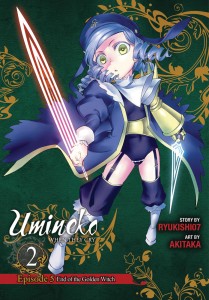Story by Ryukishi07; Art by Akitaka. Released in Japan in two separate volumes as “Umineko no Naku Koro ni: End of the Golden Witch” by Square Enix, serialized in the magazine Gangan Joker. Released in North America by Yen Press.
Umineko has a problem that Higurashi never really had, which is the fact that it is far more of an intellectual exercise. With Higurashi you had the mystery aspect of it you were trying to solve, but the primary focus was “oh my God, these poor kids, how will they avoid a tragic fate?”. Umineko has made it increasingly clear that there is no avoiding of any tragic fates, but more importantly, it’s become clearer that so much of what we’re seeing – all the meta, the increasingly ludicrous fantasy creatures and special effects shonen battles – is completely and totally bogus. Not just the “is it really witches” question, but the entire narrative.
The end of this omnibus features the witches in charge, Lambdadelta and Bernkastel, sweeping all the ‘pieces’ off the board entirely, to do the rest of the arc as a mock trial to show off how guilty Natsuhi is. The cast sits there like robots (with the exception of Battler, Natsuhi, and the witches), not really caring much about anything till they have to. It can be… hard to get invested in a plot like this. This is probably why Natsuhi made the best focus for this arc. Given choices of the other adult women we’ve seen, Rosa is a child abuser, Eva is also a child abuser (see: Ange), and Kyrie, aside from being a yakuza daughter, simply isn’t the sort who has emotional collapses. Natsuhi, who came into the Ushiromiya household as a fragile flower and has had every single one of her nerves shredded over the years, can give us realistic hysteria.
As you might gather from the cover, we get a few more new characters this time around as well. I love Dlanor – her name is a reversal of Ronald Knox, a classic mystery writer who gave us Knox’s Decalogue, a list of 10 rules that must be obeyed in mystery stories. (Yen does not explain either of those points, a shame as this series does have endnotes.) Dlanor, though, is a tiny, haughty minister of justice, here to make sure that everyone follows the RULES. Ah yes, she also has an odd Japanese verbal TIC. I was pleased to see that the official translation stuck with what Witch Hunt had done in the VN translation and gave her ending words CAPITALIZATION (or, given that comic fonts are always capitalized, BOLDNESS). It’s an excellent way to show off her ODDITY.
Dlanor is also far more sympathetic to us than Erika, despite being on her side. Of course, having spent most of the first volume letting us hate her guts, we see Erika start to lose it here. as Battler runs rings around her logic (arguably this is Lambda using Battler as her mouthpiece, but let’s let him have his fun), and many of her theories are smashed into bits. This allows her to be abused by Bernkastel, who is truly terrifying here, possibly as Erika is supposed to be her own self-insert there in Rokkenjima, and she’s humiliating the author. Erika then takes it out on Dlanor’s subordinates, of course, because where would Umineko be without cycles of abuse?
As for the standard murder mystery, it’s still not solved as of the cliffhanger, though I can give you some pretty good guesses. One thing for sure, it’s not Natsuhi, who everyone is gleefully setting up to look as guilty as possible. Not that Natsuhi is totally innocent – she has been faking Kinzo’s death for the last two years, after all, and the whole “Man from 19 Years Ago” thing does not sound done to me either despite supposedly only being Natsuhi’s guilt for wishing a baby dead followed by it happening. Assuming you don’t mind that the characters you’re invested in are frequently revealed to be the fiction they actually are, this remains an excellent series.


Speak Your Mind